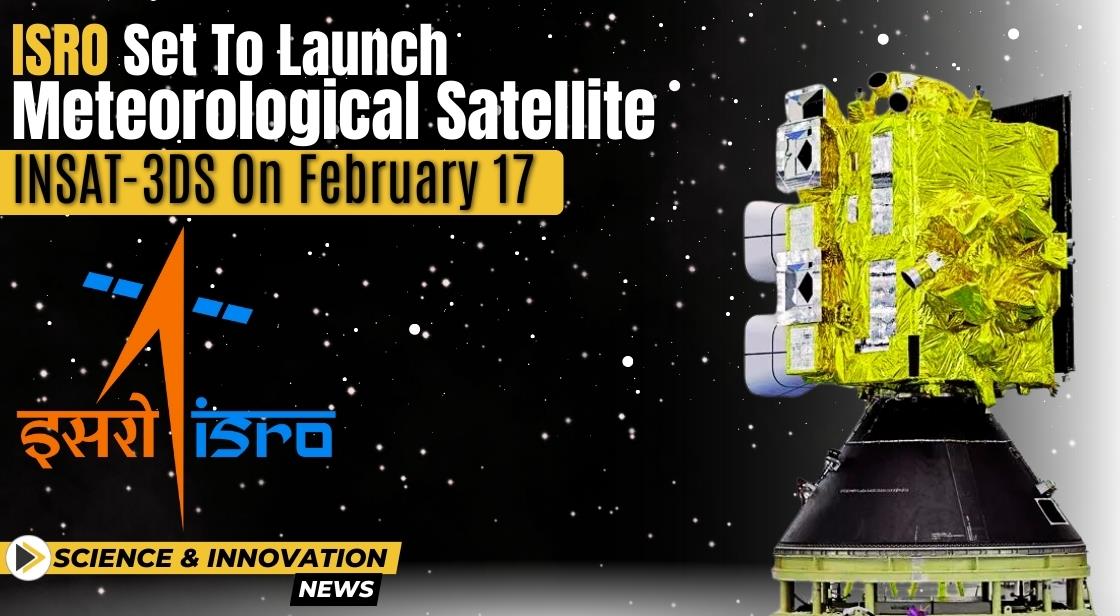ISRO Set to Launch Meteorological Satellite INSAT-3DS on February 17

News Synopsis
The Indian Space Research Organisation (ISRO) is gearing up for the launch of its meteorological satellite INSAT-3DS on February 17. The GSLV-F14/INSAT-3DS mission is scheduled for liftoff at 5.30 pm from the Satish Dhawan Space Centre (SDSC-SHAR) in Sriharikota. This marks the 16th mission for the Geosynchronous Satellite Launch Vehicle (GSLV), aiming to deploy the INSAT-3DS meteorological satellite into the Geosynchronous Transfer Orbit (GTO).
Satellite INSAT-3DS Launch Details and Objectives
In its 16th mission, GSLV-F14/INSAT-3DS is set to elevate the satellite into GTO, following which orbit-raising maneuvers will position it in a Geo-stationary Orbit, as confirmed by ISRO in a statement released on February 8. The entire mission is financially supported by the Ministry of Earth Sciences, emphasizing its significance in advancing meteorological capabilities.
This launch follows ISRO's successful start to 2024 with the XPoSAT mission launched from Sriharikota on January 1 during PSLV’s 60th flight.
INSAT-3DS Satellite: Advancing Meteorological Observations
The INSAT-3DS Satellite represents a crucial advancement in meteorological observation, belonging to the Third Generation Meteorological Satellite from Geostationary Orbit. Engineered to enhance meteorological observations, it will play a pivotal role in monitoring land and ocean surfaces, contributing to weather forecasting and disaster warning.
ISRO outlines that the satellite's primary objectives include monitoring Earth’s surface, conducting oceanic observations, and evaluating the environment in various spectral channels of meteorological importance. Additionally, it aims to provide the vertical profile of various meteorological parameters of the atmosphere, data collection and dissemination capabilities from Data Collection Platforms, and satellite-aided search and rescue services.
Collaborative Impact and Utilization
Departments under the Ministry of Earth Sciences, including the India Meteorology Department (IMD), National Centre for Medium-Range Weather Forecasting (NCMRWF), Indian Institute of Tropical Meteorology (IITM), National Institute of Ocean Technology (NIOT), Indian National Center for Ocean Information Services (INCOIS), and various other agencies, will leverage INSAT-3DS Satellite data. This collaboration aims to deliver improved weather forecasts and enhanced meteorological services.
GSLV Configuration and Capabilities
The GSLV, standing at 51.7 m in length with a liftoff mass of 420 tonnes, operates as a three-stage launch vehicle. The first stage (GS1) comprises a solid propellant (S139) motor with 139-ton propellant and four earth-storable propellant stages (L40) strapons, each carrying 40 tons of liquid propellant.
The second stage (GS2) is another earth-storable propellant stage loaded with 40-ton propellant. The third stage (GS3) is a cryogenic stage with a 15-ton propellant loading of liquid oxygen (LOX) and liquid hydrogen (LH2). Protecting the satellite during the atmospheric regime is an Ogive payload fairing.
GSLV's versatility allows it to launch spacecraft for various missions, encompassing communications, navigation, earth resource surveys, and other proprietary purposes.
Data for Decision-Making
Data collected by INSAT-3DS will be utilized by various MoES departments like the India Meteorological Department (IMD) and National Centre for Medium-Range Weather Forecasting (NCMRWF) to provide improved weather forecasts and meteorological services.
The INSAT-3DS launch signifies a crucial step in India's journey towards advanced weather forecasting and disaster preparedness. This mission, powered by collaborative efforts and cutting-edge technology, promises to safeguard lives and livelihoods by providing timely and accurate weather information.
You May Like









